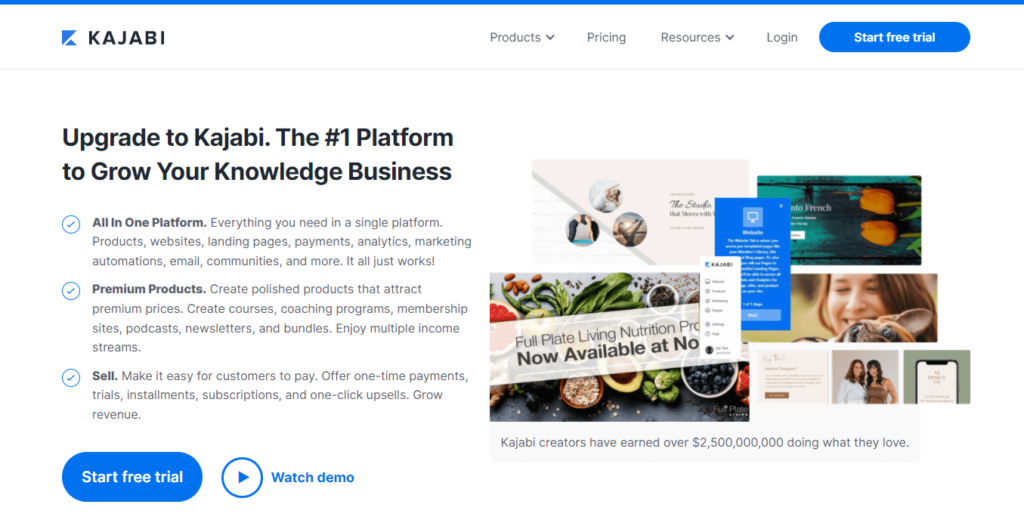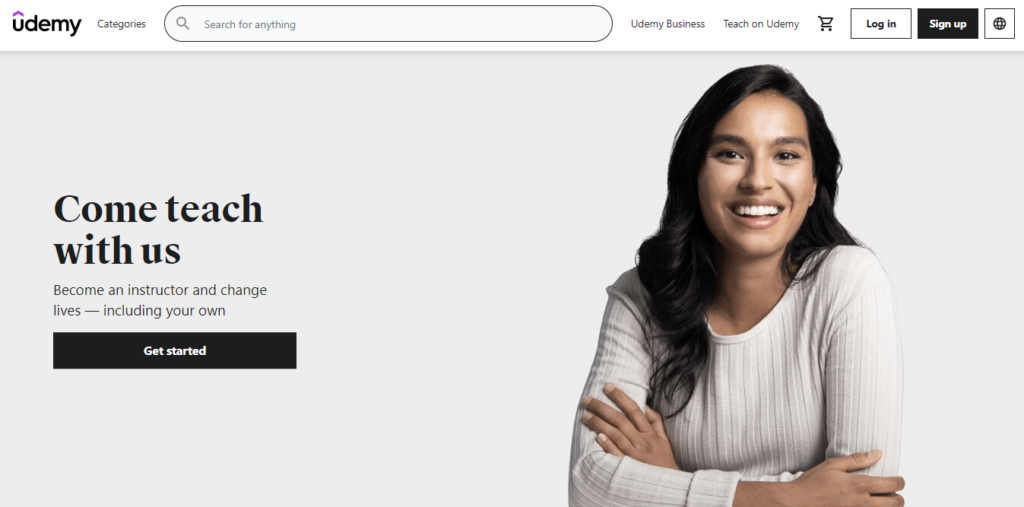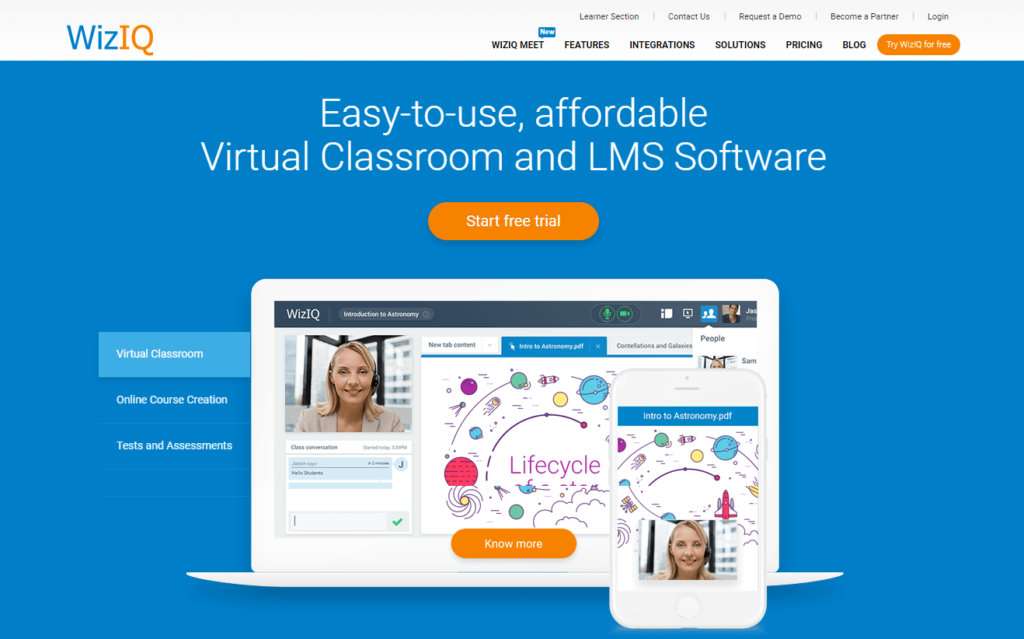Online education has revolutionized the way students learn in this digital world. Students want to enhance their professional knowledge so they can gain more expertise in their respective fields.
Courses provide the best knowledge and skills to enhance professional expertise and so online courses have gained more popularity than traditional educational services. It provides various opportunities to students globally, allowing them to learn anywhere and at any time.
To teach online courses, Web-based learning platforms are widely used.
Designing courses, sharing them with students, and earning revenue are the most common tasks performed by online course instructors using Web-based tools.
There are various online course platforms, but today we’ll discuss the top 7 best platforms to create and sell online courses.
Tabla de contenidos
What Are the Best Online Course Platforms?
The 7 best online course platforms in my experience going from a complete beginner in this field to a teacher in a year.
1. Thinkific

Thinkific is great because it has a student dashboard that shows them their progress and upcoming lessons. This way students can see how much they have to study and what they need to study. It also keeps track of lectures watched, quizzes taken, and lessons completed which is great for accountability.
It’s also extremely affordable and allows students to pay monthly or purchase a yearly plan. They also have a student app which is very helpful.
Pros & Cons of Thinkific
Pros:
- Relatively easy to use
- Offers a free and paid plan
- Can create an unlimited number of courses
- Has a built in payment system
- Can offer courses for free or for sale
- Courses can be drip fed
- Can offer coupon codes
Contras:
- The free plan is quite limited
- Not as many features as some of the other platforms
- Some users have reported issues with customer support
- Content cannot be exported off the platform
Precios
- Free ($0/month): Great to test out the features and get a feel for the interface.
- Basic ($39/month): Unlimited courses and students, drip (scheduled) content, custom domain, email integrations, and coupons.
- Pro ($79/month): Basic features, plus memberships and bundles, private courses, certificates, advanced HTML and CSS editing, assignments, live lessons via Zoom, and priority support.
- Premier ($399/month): Pro features, plus 50-course admins, onboarding package, and unlimited growth package (best for big teams).
Overall, I recommend the Thinkific platform as our #1 choice for course creators and entrepreneurs who are serious about creating, marketing, and selling their own course content.
You can get started today with a One-Month Free Trial of their Pro Plan with my link below.
2. Kajabi

Kajabi is next on my list because it has a lot of great features. On the plus side, it has a student app which makes it easily accessible for students. It also allows your lessons to be accessed from any computer or electronic device.
You can have 3 free websites with it and each one can have up to 500 pages! Another great thing is that it also has a Facebook group which is great for accountability.
Where Kajabi really excels is in its marketing automation tools. You can segment users in your list, send emails at certain times based on advanced triggers, and send professionally branded messages.
Pros & Cons of Kajabi
Pros:
- Kajabi is very easy to use
- You don’t need any technical skills to create a course
- Kajabi has a great customer support
- There is no limit to the number of courses you can create
- You can host your courses on your own domain name
- You can sell courses in multiple languages
Contras:
- The price is higher than some other platforms
- You can’t host your courses on your own domain name (you have to use a subdomain)
- Kajabi doesn’t have as many features as some other platforms
Precios
Kajabi pricing is mainly based on the number of courses and active members you have:
- Basic ($119/month): 1 website, 1 admin, 3 products, 3 pipelines, 10,000 contacts, and 1,000 active members.
- Growth ($159/month): 1 website, 10 admins, 15 products, 15 pipelines, 25,000 contacts, and 10,000 active members.
- Pro ($319/month): 3 websites, 25 admins, 100 products, 100 pipelines, 100,000 contacts, and 20,000 active members.
If you’re an established business and want to try one of the more advanced platforms on the market, Kajabi is a solid choice.
Start your free 14-day trial of Kajabi today.
3. Teachable

Teachable allows for easy-to-use pop-up quizzes that are great for keeping students on track. It also has a student app that helps with accessibility.
One of the best things about Teachable is the fact that you can earn 40% of recurring revenue from your courses! This way you get paid even after you have finished the course.
It also has a referral program that allows students to earn money for referring other students which is great!
Pros & Cons of Teachable
Pros:
- You can host your courses on your own domain name
- Teachable has a lot of features
- The price is lower than some other platforms
- You can sell courses in multiple languages
Contras:
- Teachable is not as easy to use as some other platforms
- You need some technical skills to create a course
- Teachable doesn’t have great customer support
Precios
- Basic ($29/month): 5% transaction fees, 2 admin users, drip content, course builder, members-only community.
- Pro ($99/mes): Basic features, plus no transaction fees, 5 admin users, advanced reports, and course certificates.
- Business ($249/month): Pro features, plus advanced coding customizations, 20 admins, bulk student enrollments, and group coaching calls.
Get a free 30-day trial of the Teachable Pro Plan with my link below and start building your interactive online community.
4. Podia

Podia is probably what I would recommend to most people because it has great features and an easy-to-use interface.
It has a student app that can help with accessibility and you can track your student’s progress through the dashboard! On top of that, they offer an affiliate program where you get a 20% commission on recurring revenue from your courses! Podia also has a referral program as well as course bundles to help you make money.
Pros & Cons of Podia
Pros:
- You can host your courses on your own domain name
- Podia has a 14-day free trial
- There is no transaction fee
- You can sell courses in multiple languages
- Podia incorpora una herramienta de marketing por correo electrónico
Contras:
- Podia es un poco más caro que otras plataformas
- Necesitas tener algunos conocimientos técnicos para utilizar Podia
- Podia no tiene tantas funciones como otras plataformas
Precios
- Mover ($39/mes) - Todo ilimitado, cero comisiones por transacción, venta de cursos, descargas digitales y 5k emails enviados al mes.
- Agitador ($79/mes) - Todo en Mover, más la posibilidad de crear comunidades de miembros, añadir afiliados y 15k emails enviados al mes.
- Earthquaker ($179/mes) - Todo lo que ofrece Shaker, más un gestor de cuentas dedicado, incorporación personalizada y 50.000 correos electrónicos enviados al mes.
En general, si lo que buscas es una sólida funcionalidad de afiliación y la posibilidad de aumentar tus ventas con la ayuda de afiliados, Podia es un constructor de cursos único que merece la pena probar.
Puedes registrarte y probarlo gratuitamente durante 14 días.
5. LearnDash

Esta es la plataforma que utilizo para mi curso en línea. Tiene algunas funciones estupendas, aunque no todas son gratuitas.
Existe una versión gratuita que incluye muchas funciones interesantes. Puedes seguir el progreso de tus alumnos a través del panel de control, crear cuestionarios para poner a prueba sus conocimientos y mucho más. La aplicación para estudiantes también es gratuita, ¡lo cual es increíble!
Además de eso, también permite la comercialización del afiliado donde se obtiene una comisión 10% sobre los ingresos recurrentes de sus cursos.
Pros & Cons of LearnDash
Pros:
- LearnDash es muy fácil de usar
- You can host your courses on your own domain name
- LearnDash tiene un gran servicio de atención al cliente
- You can sell courses in multiple languages
Contras:
- The price is higher than some other platforms
- LearnDash no tiene tantas funciones como otras plataformas
- You can’t host your courses on your own domain name (you have to use a subdomain)
Precios
LearnDash ofrece tres planes de pago a partir de $199/año para el plan Básico.
Todos los planes tienen las mismas características (cursos y usuarios ilimitados, 1 año de soporte, lecciones por goteo, etc.).
La diferencia radica en el número de sitios en los que puede utilizar la licencia. El plan Básico sólo permite un único sitio, mientras que los otros planes (Plus a $229/año y Pro a $369/año) le permiten utilizarlo en 10-25 sitios. Además, los planes superiores le dan acceso a un panel de control y a informes de actividad en tiempo real.
Puedes empezar hoy mismo con un descuento de $40 y una garantía de devolución del dinero de 30 días en sus planes anuales.
6. Udemy

Personalmente, nunca he utilizado Udemey, pero he oído hablar bien de él a los profesores de las escuelas en las que solía dar clases.
Tiene una ventaja competitiva porque puede adaptarse rápidamente a las nuevas plataformas en función de los dispositivos que utilicen los alumnos. Esto resulta útil cuando se produce cualquier tipo de actualización o cambio tecnológico que pueda afectar al aspecto o la transmisión del curso.
Pros & Cons of Udemy
Pros:
- Amplia variedad de cursos específicos para su nicho que puede realizar a su propio ritmo.
- La presentación del curso y su elegante reproductor de vídeo hacen más propicio el aprendizaje.
Contras:
- Valoraciones inexactas de los cursos: que un curso tenga muchas valoraciones de 5 estrellas no significa que sea bueno.
- Baja barrera de entrada para los instructores, lo que da lugar a cursos de calidad inferior.
Empieza hoy mismo con Udemy de forma gratuita.
7. WizIQ

Wiziq tiene su propia interfaz, lo que significa que no puedes utilizar plataformas de terceros para subir contenido. Esto no es necesariamente una desventaja, pero como yo nunca he utilizado personalmente la plataforma, te dejo a ti la decisión de si esto es una ventaja o una desventaja en tu situación.
Wiziq tiene un panel de control muy fácil de usar que permite a los estudiantes ver sus próximas lecciones y pruebas. También permite a los estudiantes tener una discusión con el instructor y la comunidad del curso que es bastante bueno.
Pros & Cons of Wiziq
Pros:
- Creación rápida y sencilla de sesiones de formación en directo
- Permite vender contenidos en una plataforma de venta propia
- Ofrece un amplio abanico de precios, perfecto para formadores internos o pequeños creadores de contenidos.
Contras:
- Aulas virtuales disponibles por un suplemento
- El almacenamiento adicional también requerirá el coste añadido
Si usted es un educador o un líder corporativo que quiere llegar a su audiencia en directo en cualquier parte del mundo, puede empezar con su 14 días de prueba gratuita.
Online Course Platforms – What You Need to Know Before Buying
La mayoría de las plataformas de cursos en línea son iguales. Es difícil encontrar una que reúna todas las condiciones para satisfacer sus necesidades, ya sea un profesor particular o una institución.
Estas son las principales características que hay que tener en cuenta:
Facilidad de uso: La plataforma debe ser fácil de usar, tanto para usted como administrador como para sus alumnos.
Variedad de cursos: La plataforma debe ofrecer una variedad de cursos, para que puedas encontrar uno que se adapte bien a tus alumnos.
Affordable: The platform should be affordable, so you can get the most value for your money.
These are the three key features to look for when choosing an online course platform. Keep these in mind as you compare different platforms, and you’ll be sure to find one that’s a perfect fit for your needs.
Online Course Platforms – Need to Know
Now that you have an online course platform, it’s time to start creating online courses!
Creating a course is easy with most platforms, but there are a few things to keep in mind:
- Your course should be informative and cover a specific topic in depth.
- It’s important to include multimedia content such as videos, infographics, and images to keep students engaged.
- Finally, make sure your course is well-organized and easy to navigate.
How Do I Create and Sell Online Courses?
Now that you have chosen an online course platform, it is time to create your first online course.
Creating and selling online courses can be a lucrative and rewarding way to share your expertise and knowledge with others. To get started, there are seven important steps to follow.
First, choose your topic based on your passion and expertise. Then, do some research to understand the market and determine what price to charge for your course.
Next, create your course content, including lectures, slides, and other materials. Promote your course through various channels, such as social media and email marketing.
Launch your course and monitor your progress, tracking your sales and student engagement. Finally, be flexible and make changes as needed to ensure that your course meets the needs of your students.
By following these steps, you can create and sell a successful online course and share your knowledge with the world.
For a step-by-step guide, check out this article!
Online Course Platforms FAQs.
How Much Money Can I Make Selling Online Courses?
The money you can make from selling online courses depends on the niche you choose, the course length and your marketing strategy.
For example, if you have a course that is 10 hours long and that is for a specific niche, then you can make about $10 per hour of content. If your course is an hour-long and it’s for a variety of topics, then you can make about $100 per hour of content.
If you are trying to sell your courses through ads on social media or YouTube videos, then it’s important to know that these channels tend to be more expensive than other channels like email marketing or organic search traffic.
You should also know that there are other factors like how much time it takes to create the content, how many people buy the course, and how many people you need to reach to make the course profitable.
Someone in your target audience might be interested in your course, but they might not be a very good fit for it.
Your lifetime value is the amount of profit you make from a single customer over their lifetime with all the money they spend on your products and services. This is also known as return on investment ( ROI).
What Are The Most Popular Online Courses?
Online courses are a great way to learn new skills and improve your knowledge. There are many different types of online courses you can choose from.
Some of the most popular online courses include learning how to code, learning how to design an app, learning how to create a website, and much more. Online courses can be taken by anyone who has access to the internet and is interested in learning something new.
What Are The Best Online Course Platforms?
Online courses are becoming more and more popular. They provide a great opportunity for people to learn new skills and develop their knowledge in different areas of life. There are many platforms that offer online courses, but which ones are the best?
There is a wide variety of online course platforms out there, but some stand out from the rest.
One of those is Udemy. It is one of the most popular online course platforms at the moment and has over 65 million students enrolled in its courses. Another platform that stands out is Coursera, which offers over 1500 courses on topics like business, law, computer science, and more.
Online Course Platforms (Summary)
Choosing the right online course platform is crucial to the success of your online course. Each of the platforms discussed in this article has its own unique features, pricing plans, and target audiences.
Udemy is a popular platform with a large user base and a wide range of courses, making it a great option for instructors looking to reach a large audience. Teachable, on the other hand, offers more customization options and greater control over your content.
Kajabi is a comprehensive all-in-one platform that includes everything from course creation to marketing and sales, making it a good choice for those looking for a complete solution.
Thinkific offers a user-friendly platform that is easy to use and has a variety of features, including customizable templates and integrations with third-party tools.
Podia is a versatile platform that can be used to sell courses, digital products, and even memberships. Finally, LearnDash is a popular choice for those looking to create and sell courses on their own WordPress website.
Ultimately, the best platform for you will depend on your specific needs and goals. Consider factors such as pricing, ease of use, customization options, and marketing features before making a decision. With the right platform, you can create and sell high-quality online courses that reach and engage your target audience.
I hope you guys found this article helpful. If you have any further questions please let me know! I’d be happy to answer them.
Divulgación: Hay algunos enlaces de afiliados por encima y puedo recibir comisiones por las compras realizadas a través de enlaces en este post (por supuesto, sin costo adicional para usted). pero estos son todos los productos que recomiendo encarecidamente. No pondré nada en esta página que no haya verificado y/o utilizado personalmente.

